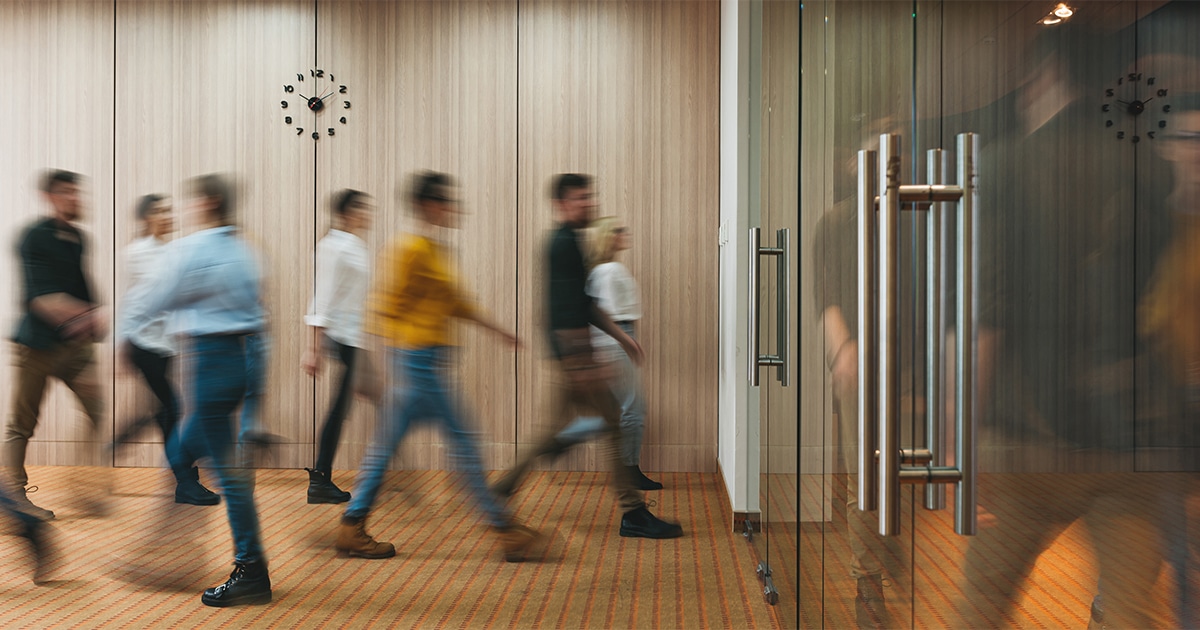A year into the pandemic and with the promise of a return to normalcy with the rollout of vaccines, companies are starting to shift from seeking COVID-19 office solutions to thinking strategically about the future of the office. With employees voicing an interest in staying remote at least part of the time, companies are assessing the implications of a “hybrid office” and how best to prepare for the changing workplace. They are also looking into hybrid workplace technology to support such an environment.
A hybrid workplace refers to an office concept that enables employees to work both in the physical office and remotely. How much time is spent away from the office and when varies from company to company or even from employee to employee, but such a shift could radically alter companies’ space needs – especially if employees work primarily from satellite offices rather than the central office. Beyond the obvious challenge of determining how much space is needed, another question is what kind of space employees will require when they come to the office so that they can make the most of their in-office experience.
Managing space in a hybrid office
One of the conclusions many companies have drawn from the pandemic is that focused work can, for many employees, be done just as well – if not better – from home as in the office. Many types of collaboration and socialization, on the other hand, are better suited to face-to-face interactions, particularly when they involve new employees. As a result, many companies expect to dramatically increase the availability of conference rooms, huddle areas, and other collaboration or flexible spaces to accommodate new ways of working.1
But even if the office becomes a collaboration hub, there is still considerable uncertainty around how much of each type of space will be needed, how intensely it will be used, and how much employees’ need for space has been changed by social distancing. The best way to answer those questions isn’t to theorize about the future of the office but to put in place the technology that allows space managers to monitor precisely how their space is actually being used and to optimize their space continually to adjust to the way office use is changing.
In addition to collaboration, another likely feature of the hybrid office is flexible seating, hoteling, or hot-desking. These concepts all represent a shift away from assigned seats towards temporary seats, which might be managed through advance reservations or ad hoc check-in/check-out processes. Flexible work concepts are not new, but many organizations are embracing them for the first time and need to put in place robust reservations systems and ideally even sensors to make them work well. Research indicates that a well-functioning flexible concept can dramatically improve workplace perception and performance, but also suggests that many offices suffer from poor implementation.2
Employee experience in a hybrid workplace
Beyond optimizing the configuration and amount of space, another concern for many workplace managers is how to create an employee-centric environment. In order to make the office an attractive destination and overcome any residual concerns over workplace safety, new features to enhance the employee experience will shape the office.
One approach taken by many companies has been to deploy workplace apps that allow building users to make reservations, find colleagues, book services, request cleaning and maintenance, and visualize indoor air quality metrics for their space. By sharing information and streamlining processes, these apps make the workplace experience more pleasant and productive. They can also give employees a greater sense of control as they transition back to the office. With the growth of the hybrid office, these existing workplace technology solutions will no doubt be augmented by new features to better connect remote and in-office employees.
Why invest in hybrid workplace technology now?
Investing in workplace technology for the physical office at a time when we expect to see fewer people in the workplace may seem counterintuitive. Why spend money on workplace technology to monitor a space that only half of your employees will use? But for space managers who want to know just how much of their lease they can give up or repurpose and how best to reconfigure their space, data will be essential. Likewise, for companies to embrace flexibility and employee experience, technologies that streamline reservations, promote well-being, and help workers manage the complexities of the hybrid office can spell the difference between a smooth return to work and chaos. While it may be tempting to follow the trends of what a “typical” return to the office might look like, we believe that basing decisions on your own utilization data will be key to success. Just as working from home has affected different business operations and demographic groups differently3, the return to the office experience will be unique to each company.

Introducing a new blog series
This blog post offers a preview of some of the questions we will be addressing in our new series on the hybrid office. Our goal will be to explore different hybrid workplace scenarios and to discuss specific hybrid workplace technology solutions for overcoming obstacles or optimizing the workplace experience for a mixed virtual and in-office workforce.
- Kane et al. (2/10/2021). “Redesigning the Post-Pandemic Workplace” MIT Sloan Management Review, Retrieved from https://sloanreview.mit.edu/article/redesigning-the-post-pandemic-workplace/
- Gensler Research Institute (2020). “U.S. Workplace Survey 2020”. Retrieved from https://www.gensler.com/workplace-surveys
- Cushman & Wakefield (2020). “The Future of Workplace: how will COVID-19 and data shape the new workplace ecosystem?”. Retrieved from https://www.cushmanwakefield.com/en/insights/covid-19/the-future-of-workplace









